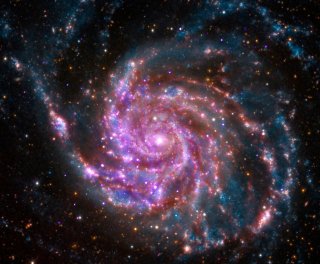Young Galaxy 12 Billion Light-Years Away Mirrors the Milky Way
Why does it look so darn similar?
Astronomers have discovered a galaxy located 12 billion light-years away that is eerily similar to that of our Milky Way.
According to the study published in the science journal Nature, the faraway galaxy, known as SPT0418-47, features a large congregation of stars located in the center and resembles a disk—much like the galaxy we live in.
Astronomers used the Atacama Large Millimeter/submillimeter Array of telescopes (ALMA) based in Chile, to pinpoint this particular galaxy. Because the light from it has traveled for more than 12 billion years to reach our eyes, we’re seeing this galaxy as it appeared when the universe was only about 1.4 billion years old.
Scientists have long thought that in the early years of the universe, galaxies were highly unstable as they formed. But what SPT0418-47 has revealed is that this theory might not be true.
“This result represents a breakthrough in the field of galaxy formation, showing that the structures that we observe in nearby spiral galaxies and in our Milky Way were already in place 12 billion years ago,” the study’s author Francesca Rizzo, a postdoctoral student at the Max Planck Institute for Astrophysics in Germany, said in a statement.
SPT0418-47’s large bulge at its center is a distinct feature of today’s galaxies that has never been seen this far back in the universe’s history.
“The big surprise was to find that this galaxy is actually quite similar to nearby galaxies, contrary to all expectations from the models and previous, less detailed, observations,” the study’s co-author Filippo Fraternali, professor of gas dynamics and evolution of galaxies at the Kapteyn Astronomical Institute of the University of Groningen in the Netherlands, said in a statement.
Given the vast distance of the galaxy, the researchers tapped into a technique called gravitational lensing, which uses the gravity of nearby galaxies to magnify distant galaxies by bending their light.
During the observation, SPT0418-47 was shown to be a near-perfect ring of light around a nearby galaxy. Advanced computer modeling then helped the researchers reconstruct the galaxy’s actual shape.
“When I first saw the reconstructed image of SPT0418-47, I could not believe it—a treasure chest was opening,” Rizzo said.
For the researchers, it was the well-formed structure and order in the young galaxy that really stood out.
“What we found was quite puzzling. Despite forming stars at a high rate, and therefore being the site of highly energetic processes, SPT0418-47 is the most well-ordered galaxy disk ever observed in the early universe,” the study’s co-author Simona Vegetti, of the Max Planck Institute for Astrophysics, said in a statement.
“This result is quite unexpected and has important implications for how we think galaxies evolve.”
Ethen Kim Lieser is a Minneapolis-based Science and Tech Editor who has held posts at Google, The Korea Herald, Lincoln Journal Star, AsianWeek and Arirang TV. Follow or contact him on LinkedIn.
Image: Reuters

